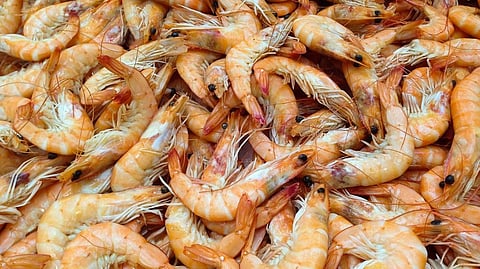Vietnam's shrimp exporters seek opportunities in China amid trade tensions with US
With export turnover reaching US$389 million (a 103 per cent increase) in the first four months of 2025, China and Hong Kong have become the largest shrimp markets for Vietnam, accounting for nearly 30 per cent of the latter's total shrimp exports, the Vietnam Association of Seafood Exporters and Producers (VASEP) confirmed earlier this week.
VASEP said this triple-digit growth is mainly driven by strong sales of Vietnamese lobster to China.
Long-term opportunities for shrimp suppliers
Recently, China announced its food and nutrition development guidelines for 2025–2030, emphasising improved dietary quality through increased protein consumption.
VASEP said the new guidelines not only highlight protein’s role but also propose policies to boost fish and seafood consumption, including integrating these products into school meal programs. This shift could significantly stimulate seafood demand, including shrimp.
VASEP expects that, in the long term, China will increase imports of mid-priced seafood products such as pangasius and medium to small-sized shrimp.
In 2023, China imported a record 4.67 million tons of seafood and maintained a high volume of 4.5 million tons in 2024. Specifically, China is one of the world’s largest shrimp importers, with over 1.10 million tons imported in 2023 and more than one million tons in 2024.
Short-term plateau in warm-water shrimp consumption
However, short-term demand for frozen warm-water shrimp in China has plateaued, including imports from its two largest suppliers, Ecuador and India.
According to Chinese customs data, China imported 70,067 tons of frozen warm-water shrimp valued at US$356 million in April 2025—up five per cent in volume and six per cent in value compared to the same month last year. In the first four months, imports totaled 269,689 tons worth US$1.45 billion, down nine per cent in volume but up one per cent in value year-on-year, with average prices rising 11 per cent to US$5.36/kg.
Ecuador remains China’s largest supplier, accounting for 75 per cent of China’s shrimp imports by volume, delivering 203,100 tons valued at US$1.013 billion in the first four months—down seven per cent in volume but up four per cent in value.
India, the second-largest supplier, saw declining shipments in April. VASEP said continuous import decreases reflect reduced demand from Chinese processors for headless shrimp, India’s main export product to China used for reprocessing and domestic sales.
In the first four months, imports from India dropped 21 per cent to 33,187 tons, the lowest volume since 2022, and well below the 2019 record.
This trend has been attributed to China’s "sluggish" economy, rising domestic shrimp production, competition from various popular seafood items, and consumer behavior sensitive to macroeconomic pressures, according to VASEP.
Impact of US-China trade tensions on Vietnamese shrimp in China
As the US escalates retaliatory tariffs on key Chinese goods, China faces pressure to reorient exports and boost domestic consumption. VASEP said this could positively affect domestic food sectors, including protein-rich shrimp, which the Chinese government encourages.
Moreover, restricted access to the US market could force Chinese processors to focus on domestic consumption or re-export to non-US markets, increasing stable demand for raw materials with clear traceability—such as Vietnamese shrimp—offering growth opportunities.
VASEP said that, compared to Ecuador and India, Vietnam benefits from geographic proximity, lower shipping costs, stable trade relations, and high-quality reliability, positioning Vietnamese shrimp well to expand market share in China.
The association admitted, however, that risks remain, including exchange rate fluctuations of the Chinese yuan, stricter import technical controls, and a potential preference for domestic products during economic hardship. China’s own large shrimp production industry may also ramp up exports to alternative markets due to US restrictions, intensifying competition against Vietnamese shrimp.
What Vietnamese shrimp exporters should do
According to VASEP, to seize opportunities from the US-China trade dynamics and China’s new food policies, Vietnamese shrimp exporters need to strengthen cooperation with local distribution channels (wholesale markets, supermarket chains, e-commerce platforms) to directly reach Chinese consumers.
The association also recommends that exporters diversify product segments, ranging from medium-sized shrimp to high-value products like lobster and fresh tiger shrimp, tailored to different consumption regions; strictly comply with food safety, traceability and origin standards to maintain credibility in formal trade; and leverage trade agreements such as RCEP and ACFTA to reduce import costs and enhance competitiveness against rivals.


